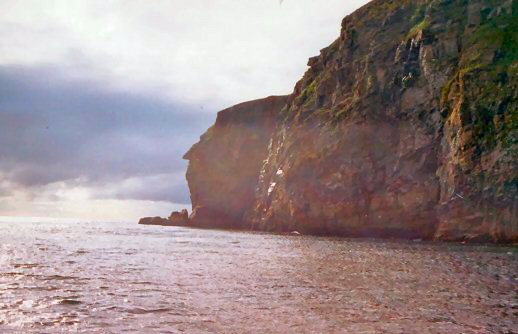We are almost never conscious that we are witnesses to the end of an era.
I was in Teelin in the Summer of ’82 (and many othersummers besides) and it was of the early autumn there that year that Ciaran Carson of Belfast wrote:
Before the Storm: Cliffs of Slieve League
‘It is the morning after the night before and snatches of the night before – fiddle tunes, hubbub, the clink of glasses – keep filtering through from the memory bank.
We are driving out to the coast to clear our heads – or rather, up to the coast, towards Slieve League, the highest sea-cliff in Western Europe, following this precipitous erratic mountain route that winds between stone walls, potato drills, stone-littered patchy fields, one man idling over a spade who raises his hand in an understates rhetoric of hail or farewell, and the clouds piled high between mountains, while these fiddle tunes keep coming back insistently, hectic, passionate and melancholic: half-remembered fragments. The bits and pieces of the landscape sidle into place, accommodated by the loops and spirals of the road, its meditated salients and inclines: and now, as at other times, I wonder if the disciplined wildness of Donegal music has anything to do with this terrain.
For nature here is never wholly pristine or untouched: the land is possessed and repossessed, named, forgotten, lost and rediscovered; it is under constant dispute; even in its dereliction it implies a human history.
A line of a sentimental song comes back to me:
‘Sure your hearts are like your mountains in the homes of Donegal’.
Presumably the writer intended that we read ‘big’ for ‘mountains’; yet mountains are also hard and stony; they are barriers to be circumvented or defeated. In Donegal fiddle music, this unconscious irony is transformed into purposeful energy. It is a music of driving, relentless rhythm that teeters on the edge of falling over itself; it seems to almost overtake itself, yet reins in at the brink. A jagged melodic line is nagging at me as we come upon the green vale of Bunglas, with its fairy-tale white cottages with leprechaun figurines in the gardens.
Then suddenly we are at a high promontory and the sea appears out of nowhere. On the right, the immense absurd precipice of Slieve League falls into a tiny silent line of foam, some rocks. How far away is it? The eye has nothing to scale: a human figure, if you could imagine it against this, would be lost; that seagull hovering over there is either miles away, or just within reach.
Turning back to the sea again, you can hear it, if you listen very closely: a vast lonesome whispering that stretches all the way to North America’.
…
As I write now, my son and daughter-in-law ring me from that very spot: they are on holiday in the enchanting Bunglas. I rejoice that they learned of this beauty from me, and want to re-visit it.
We drove the same route as Ciaran Carson many times; and in the company of one of Donegal’s finest fiddlers, the late James Byrne of Menacross. One time Dan Mussen of Hilltown worried as the road camber leaned us at an acute angle towards the precititous cliffs to our left:
‘Lean over to the right! Quick! All of ye! Right!”
That man leaning on the spade could well have been Thomas Cunningham, another friend, a banjo-player extraordinaire and a local to Bunglass.
Sean Con Jonny (Byrne), singer and guitarist, from that cottage on the roadside between Carrick and Bunglas, climbs to that viewpoint every day in life.
It’s rare that you get locals who so richly enjoy and applaud their environment like these men.
I miss them.
And that view.
Even the sea-gulls.
Maybe September!
… but James is gone to a better place …
